Cactus Garden
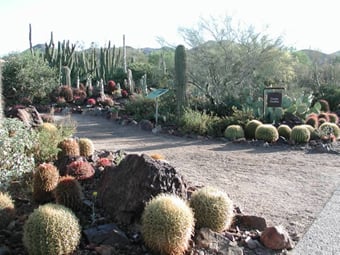
The Cactus Garden is a regional collection of cacti and succulents grouped by growth forms and specific genera. While walking through the garden you will be able to view dozens of species. Popular groups are Opuntias (prickly pears and chollas), Ferocactus (barrels), Agaves, Columnar cacti, Echinocereus (hedgehogs), and soon to include Mammillarias (pincushions).
Cactaceae (cactus family)
The enormous popularity of cacti among gardeners and plant collectors is surpassed only by that of roses and orchids. Their appeal extends far beyond their native habitat; there are legions of devotees in the eastern United States, Europe, and Japan. The desire to possess these strange yet beautiful plants supports hundreds of specialty nurseries; the largest shops grow and sell millions of plants annually. Cacti are one of the reasons tourists visit the American southwest.
Most people think they know a cactus when they see one, but they are often mistaken. All cacti are succulents, but not all succulents are cacti. Agaves, ocotillos, aloes, and the succulent euphorbias (such as African milk trees) are among the swollen or spiny plants often mistaken for cacti. However, the term cactus refers to a particular family of plants defined by a distinctive flower pattern. To be a cactus, the plant must produce flowers with the following characteristics: many tepals (combined sepals and petals) that intergrade with each other; many stamens (usually hundreds), and numerous stigma lobes (rarely only three). If a plant lacks such a flower, it cannot be a cactus.
The majority of cactus species are pollinated by numerous species of bees, a number of which specialize in cacti. Cactus bees are all solitary, but in some species the females congregate by hundreds of thousands at nesting sites to dig their individual nest burrows, which are densely concentrated in an area of a few thousand square feet. Cactus pollen is packed into these burrows to feed the grubs, which the parents do not tend. Some cacti are pollinated by birds, moths, or bats.
Organ Pipe Cactus
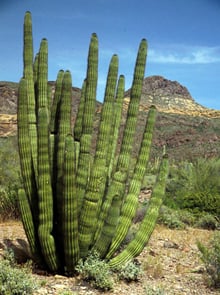
The many, usually unbranched stems that arise from ground level readily distinguish an organ pipe cactus from a saguaro. The stems also are thinner, and have solid woody cores. Plants are usually 9 to 11 feet (2.7-3.4 m) in height, but occasionally exceed 20 feet (6.1 m). The pinkish-white flowers, produced from April through August, open after dark and close shortly after sunrise. The spines on the fruit loosen and fall at ripeness. The juicy, sweet, red pulp contains many tiny seeds.
This tropical cactus is more frost sensitive than the saguaro, so it is restricted to the warmest microhabitats at its northern limit in the United States. It is most often found on south-facing rocky slopes below 3300 feet (1000 m) in elevation.
Nectar-feeding bats are the primary pollinators and some of the major seed dispersers. Because the flowers close at daybreak, diurnal animals are not significant pollinators as they are of saguaros. The fruits of organ pipe cactus are widely regarded as the second-best-tasting fruit of all cacti (after those of Stenocereus gummosus). Commercial harvest is feasible in some large populations, and fruits are sold in markets in Sonora and Baja California.
Senita
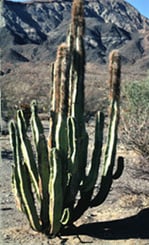
Senita generally grows 10 to 13 feet (3 to 4 m) tall and has the same general form as organ pipe cactus. It differs in having stems with only 5 to 7 (rarely up to 10) ribs and very short spines on the juvenile stems, giving them a sharply angular aspect. Mature (flower-producing) stems are quite different; they're densely covered with long, bristly, gray spines. Pink, nocturnal flowers about an inch (2.5 cm) in diameter emerge through the bristles from April through August; they emit an unpleasant odor. They are followed by marble-sized red fruits with juicy red pulp.
Senita has a recently discovered mutualistic relationship with a moth that deliberately pollinates the flowers and uses the developing fruit as food for its larvae. The relationship is very similar to that of the yucca and its pollinating moth, and only the third such example of a tight pollination-related mutualism known in the world. Senitas are very long-lived. When sites in Baja California photographed in 1905 were revisited in the 1990s, nearly every senita was still present.
Fishhook barrel
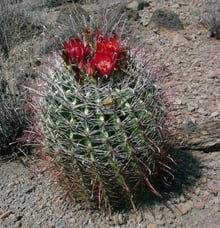
The thick, barrel-shaped body of this cactus is usually 2 to 4 feet (0.6-1.2 m) tall, occasionally reaching over 10 feet (3 m). The ribs bear broad, flat, strongly-hooked central spines as well as several bristly radial spines, but not enough of these to obscure the stem. The flowers are not strongly crowded by the spines and open wide. Flower color is extremely variable; on most plants they are some shade of orange, often with a stripe of darker shade on each petal. About 10percent of the plants have yellow or red flowers. They are produced over a 2-month-long season, August and September, much longer than the blooming period of other barrels.
Cactus bees (Lithurge spp.) pollinate the flowers. The fruit persists until it is removed by animals and may remain on the plant for more than a year. Birds, squirrels, and large mammals such as deer and javelina are the main consumers of the fruit. Plants grow fairly slowly, and large specimens are more than a century old. In cultivation, with supplemental water and fertilizer, they reach flowering size of 10 inches (25 cm) diameter and the same in height in about 12 years.
Engelmann prickly pear
Engelmann prickly pear is a shrubby cactus forming hemispherical mounds up to 5 feet (1.5 m) high and 2 or 3 times as wide. Pad size varies with individual plants; the largest are over a foot (30 cm) long. (these giants may be hybrids with other species.) The spines are also variable. The O'odham recognize this variability in applying 4 or 5 names to different forms. The flowers are yellow, about 3 inches (8 cm) in diameter, and bloom in May near the end of the spring flowering season. They last a day each, and those of some plants age to orange by afternoon. The juicy fruit ripens to varying shades (from plant to plant) of rich purple to red. The specific status of this plant is still in dispute; it has been shuttled between Opuntia phaeacantha, O. discata, and O. engelmannii by different taxonomists during the past few decades.
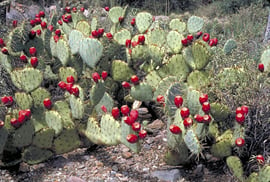
Engelmann and several other species of common, large prickly pears present an ecological mystery. The juicy, palatable fruits ripen in tremendous numbers in July and August. Most saguaro fruits, produced in similar abundance earlier in the summer, are devoured the same day they ripen. But Engelmann prickly pear fruits persist for several months. Though they are eaten by a wide variety of animals including rabbits, packrats, javelina, deer, squirrels, numerous birds, desert tortoises, and cactus beetles, there are far too many fruits for them to consume. Moreover, the fruits in the centers of large plants are out of reach of several of the wildlife species that would eat them; many of these fruits are still present in November fermenting and shriveling. Why would a plant seemingly waste energy in such overproduction? Could there be a vacant niche, a missing seed-disperser? The large, very hard seeds offer another possible clue. It has been suggested that some prickly pears coevolved with the now-extinct giant mammals, such as mammoths and ground sloths. It's an intriguing theory and, if proven true, further illustrates the already-established fact that natural systems are anything but static.
Beavertail cactus
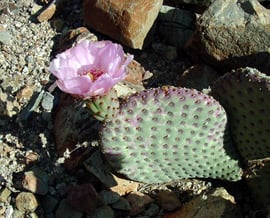
New pads of this species grow mostly from bases of older ones, resulting in sprawling plants seldom more than 2 pads tall. Clumps grow up to 6 feet (1.8 m) in diameter. The pads are spineless, but have many hair-like glochids that make the areoles look like dots of felt. The incandescent-pink flowers appear from late February at the lowest elevations to May at the highest. The dry fruits contain very large seeds, even for an opuntia.
Nearly everyone who has had a close encounter with this or other ãspinelessä opuntias would rather have dealt with spines. Glochids are often too small to see, and they cause prickling pain and intense itching as the barbs work deeper into the skin with every movement. Removing hundreds or thousands of them after falling into such a plant is an exhausting and tormenting task. Some people shave them off at skin level, which somewhat reduces the irritation, even though this leaves the tips beneath the skin. A better remedy is to gently draw very sticky tape across the afflicted skin. Another effective treatment is to cover the area with a layer of white glue, then peel it off after it dries.
Teddy bear cholla

This distinctive cholla has a vertical trunk 3 to 5 feet (1-1.5 m) tall with densely-packed horizontal side branches on the upper foot (30 cm) or so. Older, lower side branches die and fall off. The joints are very densely spined; very little of the living surface can be seen through its armor. The spines are especially sharp and strongly-barbed. Young spines are yellow and become black with age. Yellow-green flowers in spring are followed by spineless fruits that usually contain no fertile seeds.
The detached joints will readily generate new plants by rooting and branching. During the cooler months the terminal joints are detached by a slight touch by a passing animal, or even strong winds. The joints that attach to animals may be transported considerable distances before being dislodged. Since the fruits rarely contain viable seeds, this species reproduces almost entirely by this asexual process. Many plants have 3 sets of chromosomes instead of the ordinary 2; these are usually sterile. In some localities they form nearly impenetrable stands that occupy as much as 2 square miles of land almost to the exclusion of other plants. These giant, hillside-engulfing cholla forests may be a single (clonal) plant.
